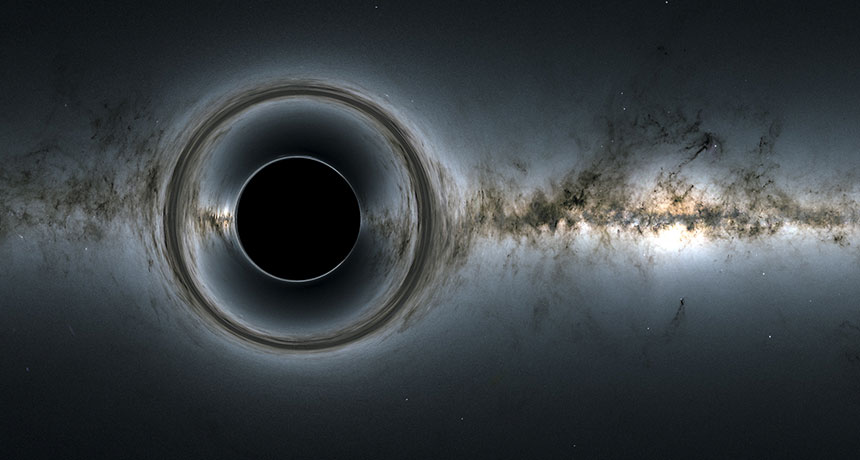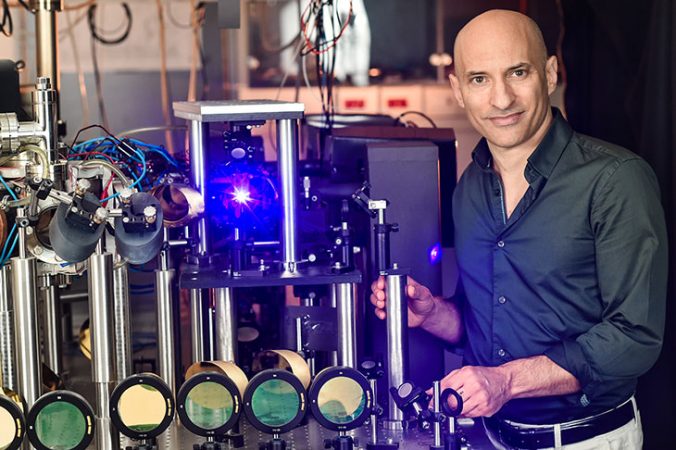Black holes might have a temperature
A lab-made mock black hole spit out radiation, suggesting Stephen Hawking was right

A black hole (illustrated) isn’t completely black. It probably emits a faint haze of particles. Scientists have now taken the temperature of the haze around a lab-made black hole and confirms these objects are only mostly dark.
NASA’s Goddard Space Flight Center; Background: DPAC/Gaia/ESA
Black holes are huge voids in space that trap light inside of them. Because they take in energy but supposedly don’t give any off, black holes should be dark and cold. But they may not be totally black and absolutely cold. At least that’s according to a new study. In it, physicists took the temperature of a black hole. Well, sort of. They measured the temperature of a pseudo black hole — a black hole simulated in the lab.
This simulated version traps sound, not light. And tests with it now appear to offer evidence for an idea first proposed by the famous cosmologist Stephen Hawking. He was the first to suggest that black holes aren’t truly black. They leak, he said. And what flows out of them is an extremely tiny stream of particles.
Truly black objects emit no particles — no radiation. But black holes might. And if they do, Hawking had argued, they wouldn’t be truly black.
The stream of particles that leak from a black hole is now referred to as Hawking radiation. It’s probably impossible to detect this radiation around true black holes, the ones in space. But physicists have spotted hints of similar radiation flowing from simulated black holes that they created in the lab. And in the new study, the temperature of the lab-made, sound-based — or sonic — black hole is similar to what Hawking suggested it should be.
This is a “very important milestone,” says Ulf Leonhardt. He is a physicist at the Weizmann Institute of Science in Rehovot, Israel. He was not involved with the latest study, but says of the work: “It’s new in the entire field. Nobody has done such an experiment before.”
If other scientists do similar experiments and get similar results, that could mean Hawking was right about black holes being not totally black.

Making a lab-based black hole
To take a black hole’s temperature, physicists first had to make one. That was the task Jeff Steinhauer and colleagues took on. Steinhauer is physicist at Technion-Israel Institute of Technology. It’s in Haifa, Israel.
To make the black hole, his team used ultracold atoms of rubidium. The team chilled them to nearly the point at which they would be absolutely still. That’s called absolute zero. Absolute zero occurs at -273.15 °C (-459.67 °F) — also known as 0 kelvin. The atoms were in gas form and very far apart. Scientists describe such a material as a Bose-Einstein condensate.
With a little nudge, the team set the chilled atoms flowing. In this state, they prevented sound waves from escaping. That mimics how a black hole prevents the escape of light. In both cases, it’s like a kayaker paddling against a current too strong to overcome.
But black holes can let a bit of light slip out at their edges. That’s because of quantum mechanics, the theory that describes the often weird behavior of things at the subatomic scale. Sometimes, quantum mechanics says, particles can appear in pairs. Those particles appear out of seemingly empty space. Normally, the pairs of particles immediately destroy one another. But at a black hole’s edge, it’s different. If one particle falls into the black hole, the other can escape. That escaping particle becomes part of the stream of particles that comprise Hawking radiation.
In a sonic black hole, a similar situation occurs. Sound waves pair up. Each tiny sound wave is called a phonon. And one phonon can fall in the lab-made black hole, while the other escapes.
Measurements of phonons that escaped and those that fell into the lab-made black hole allowed the researchers to estimate the temperature of the simulated Hawking radiation. The temperature was 0.35 billionths of a kelvin, just the tiniest bit warmer than absolute zero.
Concludes Steinhauer, with these data “we found very good agreement with the predictions of Hawking’s theory.”
And there’s more. The result also agrees with Hawking’s prediction that the radiation would be thermal. Thermal means that the radiation behaves like the light emitted from something warm. Think of a hot electric stovetop, for example. The light coming from a hot, glowing object comes with certain energies. Those energies depend on how hot the object is. The phonons from the sonic black hole had energies that matched that pattern. That means they, too, are thermal.
There’s a problem with this part of Hawking’s idea, however. If Hawking radiation is thermal, then it causes a conundrum called the black hole information paradox. This paradox exists because of quantum mechanics. In quantum mechanics, information can never really be destroyed. This information can come in many forms. For instance, particles can carry information, just as books can. But if Hawking radiation is thermal, information might be destroyed. That would violate quantum mechanics.
The information loss happens because of the particles escaping the black hole. When they escape, the particles take tiny bits of a black hole’s mass with them. That means a black hole is slowly disappearing. Scientists don’t understand what happens to the information when a black hole finally disappears. That’s because thermal radiation doesn’t carry any information. (It tells you how warm the black hole is, but not what fell into it.) If Hawking radiation is thermal, information can’t be carried away by the escaping particles. So the information could be lost, violating quantum mechanics.
Unfortunately, lab-made, sonic black holes may be no help in understanding if this violation of quantum mechanics actually happens. To know if it does, physicists will probably need to create a new theory of physics. It will probably be one that combines gravity and quantum mechanics.
Creating that theory is one of the biggest problems in physics. But the theory wouldn’t apply to sonic black holes. That’s because they’re based on sound and aren’t created by gravity. Explains Steinhauer, “The solution to the information paradox is in the physics of a real black hole, not in the physics of an analog black hole.”







